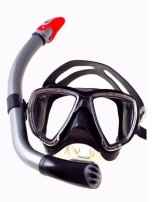
We should distinguish between basic equipment (which is mandatory) and secondary equipment - items needed for scuba diving but not compulsory, and which can potentially be rented from any diving centre when required.

Basic Equipment
- Diving Mask - This is one of the most fundamental parts of diving equipment as it allows you to see underwater and enjoy breathtaking landscapes. The mask is made of silicone and may have one or two lenses, providing completely clear vision thanks to an air space between your eyes and the water. Ensure it fits your face properly to prevent water leakage. The nose must be enclosed in flexible material while still allowing you to inhale air through it (this prevents the suction effect that could damage your eyes). Glasses wearers needn't worry as some mask models can accommodate prescription lenses.
- Snorkel - An excellent solution for those not wishing to dive deep. Designed for surface swimming while observing underwater species. It consists of a plastic tube that stays above water and a mouthpiece for breathing.
- Wetsuit - Prevents hypothermia by insulating you from cold water. There are 3 types: wetsuits, semi-dry suits and drysuits. The first are made from materials like neoprene, with efficiency depending on foam thickness. Semi-dry suits reduce water entry between fabric and skin, while drysuits are for experts as they require careful handling.
- Fins - These let you move more easily, maximising leg propulsion while reducing fatigue. Your choice depends on diving style - longer fins provide more speed while shorter ones offer less speed but reduce tiredness.
- Booties - Protect feet from fin friction and cold
- Weight Belt - Enables deeper diving by compensating for positive buoyancy.
- Diving Cylinder - Unless you consider it essential, buying one isn't recommended as maintenance is quite expensive if you don't dive regularly. It contains compressed air for breathing during dives.
- Regulator - Controls air pressure from the cylinder to enable breathing.

- Dive Computer - Watch, pressure gauge, depth gauge and dive tables with air. Monitoring time underwater and depth is crucial for safety and to prevent nitrogen build-up in the body.












